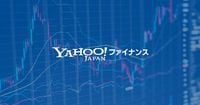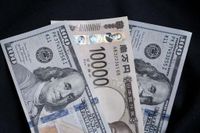The dollar-yen exchange rate faced significant selling pressure on April 2, 2025, as it temporarily fell to 148.90 yen. This movement followed a brief spike to 150.49 yen after U.S. President Trump's speech, which outlined a new mutual tariff plan that sent shockwaves through the financial markets. The announcement of tariffs, particularly a minimum 10% levy on all goods imported into the U.S., triggered a risk-off sentiment, prompting investors to favor the yen and sell off dollars.
Initially, the dollar rose sharply as Trump began his address, but the mood shifted dramatically once the specifics of the tariff structure were revealed. The tariffs included a staggering 34% on goods from China, 20% for the European Union, 24% for Japan, and an eye-popping 46% for Vietnam. This led to a significant decline in U.S. stock futures, which further fueled the yen's appreciation against the dollar. The dollar fell below the previous day's low of 149.10 yen, reaching a low of 148.90 yen at one point.
Market reactions were swift and negative. Following the tariff announcement, stocks and yields plummeted in after-hours trading. The yen's rise was notable, as it reached the 149 yen level against the dollar after the tariff details were disclosed. The U.S. Treasury market also reacted, with the five-year yield hitting its lowest point of the year earlier that morning.
In New York foreign exchange trading, the dollar was reported at 149.39 yen, down 0.15%. The euro also gained ground, trading at 1.0855 against the dollar, as reports surfaced that the EU was preparing emergency support measures in response to Trump's tariffs.
Kristina Hooper, a senior portfolio manager at Invesco, expressed concerns about the potential negative impact of Trump's tariffs on U.S. economic growth. She stated, "This could actually become a significant story of dollar weakness, which is our main concern." Similarly, Mark McCormick from TD Securities commented on the uncertainty surrounding the shift from a globalized economy to a more domestic-focused one, stating, "No one knows what kind of world awaits us on the other side of this transition."
Despite the uncertainty, hedge funds have notably reduced their long positions on the dollar since January, though they still maintain a bullish outlook, according to data from the Commodity Futures Trading Commission (CFTC).
In the stock market, the S&P 500 index rose by 0.67% to 5670.97, while the Dow Jones Industrial Average increased by 0.56% to 42225.32. The Nasdaq Composite Index saw a 0.87% rise to 17601.05. However, the S&P 500 had previously dipped more than 1% before recovering, indicating volatility in response to the tariff news.
Amidst the market fluctuations, Tesla's shares surged by 5.3% following reports that Elon Musk might step down from his advisory role to President Trump, allowing him to focus more on the company. Musk dismissed the reports as "Fake News" on social media platform X. Additionally, Amazon proposed to the White House to buy TikTok's U.S. operations, which also contributed to market excitement.
Dave Lutz from JonesTrading suggested that the tariff announcement could be perceived as a "buy the news" event, as it might eliminate some uncertainty surrounding the situation. In contrast, Andrew Brenner of NatAlliance Securities downplayed the potential impact of the tariffs, suggesting they may not be as detrimental as feared.
Concerns about the tariffs' effects on the economy remain prevalent. Oliver Blackbourn from Janus Henderson noted that while there are worries about the tariffs, U.S. stocks still appear relatively expensive. Matt Maley from Miller Tabak remarked that the announcement may have a short-term negative impact on stocks, indicating that the market might need to retest March's lows to fully adjust to the current economic fundamentals.
In the bond market, U.S. Treasury prices rose after initially reacting negatively to the tariff announcement. The five-year yield reversed after reaching its lowest level since October of the previous year. The 30-year Treasury yield stood at 4.50%, down 0.63%, while the 10-year and two-year yields were at 4.12% and 3.85%, respectively.
Options traders are anticipating further gains in U.S. bonds, reflecting expectations of a significant interest rate cut. A recent survey by JP Morgan Chase indicated a spike in net long positions among clients, suggesting a bullish sentiment in the bond market.
As the financial markets continued to digest the implications of the tariff announcement, crude oil prices rebounded. Traders appeared to be weighing the potential impact of the tariffs alongside the broader market trends. NYMEX West Texas Intermediate (WTI) crude futures for May rose by 51 cents, or 0.7%, to $71.71 per barrel, while ICE Brent crude for June increased by 0.6% to $74.95.
Gold prices also saw a rebound, with spot gold rising by $8.70, or 0.3%, to $3122.08 per ounce. The anticipation surrounding the tariff announcement had created volatility in the financial markets, and gold, often seen as a safe haven, resumed its upward trajectory toward record highs.
In summary, the announcement of Trump's mutual tariff plan has sent ripples through the financial markets, resulting in a notable rise in the yen against the dollar, a decline in U.S. stocks, and fluctuations in bond and commodity prices. As investors brace for the potential implications of these tariffs on the economy, the market remains highly sensitive to further developments in this ongoing story.



